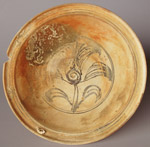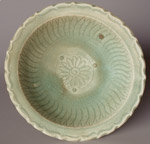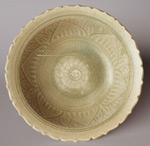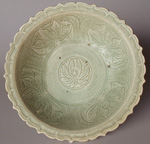
The Turiang shipwreck (+/- 1370)
This plate is decorated with black iron oxide under a clear glaze, a technique which at Sisatchanalai pre-dated celadon. (The only celadon plates found on this ship were from China.) Flowers and fish were the most common motifs. Sukhothai wares withstood their prolonged immersion in salt water better than contemporary products from Sisatchanalai, showing that they were fired at a higher temperature. The interior shows scars from a spur disc, used for stacking the wares in the kiln.
This plate is decorated with black iron oxide under a clear glaze, a technique which at Sisatchanalai pre-dated celadon. (The only celadon plates found on this ship were from China.) Flowers and fish were the most common motifs. Sukhothai wares withstood their prolonged immersion in salt water better than contemporary products from Sisatchanalai, showing that they were fired at a higher temperature. The interior shows scars from a spur disc, used for stacking the wares in the kiln.

By the time this ship sailed, celadon production had started at Sisatchanalai, and replaced underglaze ware. Although spur marks continue to disfigure the surface, the glaze is thicker, and firing control has greatly improved. Forms are deeper, foot-rings higher, and incised decorations have been introduced. Common motifs are lotus petals - as seen on the cavetto, or curved inner surface, of this plate - and 'onionskin'. Celadon plates of this period have no exterior decoration.

Celadon production at Sisatchanalai can be seen to have developed rapidly. Well-balanced forms and well-executed decoration are now common. Decoration on plates is limited to 'onionskin' and lotus petals, but upright shapes feature elaborate lotus flowers. Relatively good condition after immersion suggests that firing control was well maintained. Note the absence of spur marks on the interior.

Plates and ring-handled jars from this period represent the peak of Sisatchanalai celadon craftsmanship. Incised decorations are exquisite. The entire repertoire of floral and geometric motifs is represented. Carved striations have been added to the exterior, and rims are often perfectly foliated. Celadons from the Royal Nanhai are art-objects created by master craftsmen.
From
the collection of Kildegaard Galbo.